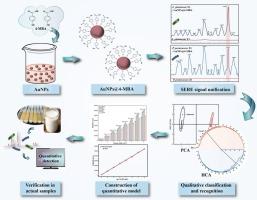SERS signal unification strategy: Preparation of AuNPs@4-MBA and its quantitative detection in mixed lactic acid bacteria
IF 4.6
2区 化学
Q1 SPECTROSCOPY
Spectrochimica Acta Part A: Molecular and Biomolecular Spectroscopy
Pub Date : 2025-09-09
DOI:10.1016/j.saa.2025.126929
引用次数: 0
Abstract
In order to realize rapid identification of different species of lactic acid bacteria and rapid quantitative detection of mixed lactic acid bacteria. In this study, L. plantarum Y1 and P. pentosaceus Z1 were used as research subjects, and AuNPs@4-MBA was prepared as the SERS substrate material for the acquisition of SERS spectra of different species of lactic acid bacteria and the construction of taxonomic identification models and SERS digitized quantitative equations. The results showed that the enhancement factor of AuNPs to 4-MBA was 3.08 × 102, and the reproducibility was excellent (RSD < 10 %). With AuNPs@4-MBA as the base material, the differences of SERS peaks between L. plantarum Y1 and P. pentosaceus Z1 could be clearly distinguished. Principal component analysis (PCA) and cluster analysis (LDA) could completely visually classify and identify different species of lactic acid bacteria. The SERS quantitative equation y = 7509.32×-5942.69, R2 = 0.99 and the detection limit lower than 10 CFU/mL was determined by the construction of SERS detection and quantitative model for different ratios and concentrations of mixed lactic acid bacteria. In the complex environment matrix, the detection accuracy of mixed lactic acid bacteria by this method reached 96.34 % to 103.54 %. It provides a promising technical strategy for rapid qualitative and real-time quantitative monitoring of mixed lactic acid bacteria.

SERS信号统一策略:AuNPs@4-MBA的制备及其在混合乳酸菌中的定量检测
为了实现不同种类乳酸菌的快速鉴定和混合乳酸菌的快速定量检测。本研究以L. plantarum Y1和P. pentosaceus Z1为研究对象,制备AuNPs@4-MBA作为SERS底物材料,用于获取不同种类乳酸菌的SERS光谱,构建分类鉴定模型和SERS数字化定量方程。结果表明,AuNPs对4-MBA的增强因子为3.08 × 102,重现性良好(RSD < 10%)。以AuNPs@4-MBA为基材,可以明显区分植物L. plantarum Y1和P. pentosaceus Z1的SERS峰差异。主成分分析(PCA)和聚类分析(LDA)可以完全直观地对乳酸菌进行分类和鉴定。通过构建不同比例和浓度混合乳酸菌的SERS检测和定量模型,得到SERS定量方程y = 7509.32×-5942.69, R2 = 0.99,检测限小于10 CFU/mL。在复杂的环境基质中,该方法对混合乳酸菌的检测准确率达到96.34% ~ 103.54%。为混合乳酸菌的快速定性和实时定量监测提供了一种有前景的技术策略。
本文章由计算机程序翻译,如有差异,请以英文原文为准。
求助全文
约1分钟内获得全文
求助全文
来源期刊
CiteScore
8.40
自引率
11.40%
发文量
1364
审稿时长
40 days
期刊介绍:
Spectrochimica Acta, Part A: Molecular and Biomolecular Spectroscopy (SAA) is an interdisciplinary journal which spans from basic to applied aspects of optical spectroscopy in chemistry, medicine, biology, and materials science.
The journal publishes original scientific papers that feature high-quality spectroscopic data and analysis. From the broad range of optical spectroscopies, the emphasis is on electronic, vibrational or rotational spectra of molecules, rather than on spectroscopy based on magnetic moments.
Criteria for publication in SAA are novelty, uniqueness, and outstanding quality. Routine applications of spectroscopic techniques and computational methods are not appropriate.
Topics of particular interest of Spectrochimica Acta Part A include, but are not limited to:
Spectroscopy and dynamics of bioanalytical, biomedical, environmental, and atmospheric sciences,
Novel experimental techniques or instrumentation for molecular spectroscopy,
Novel theoretical and computational methods,
Novel applications in photochemistry and photobiology,
Novel interpretational approaches as well as advances in data analysis based on electronic or vibrational spectroscopy.

 求助内容:
求助内容: 应助结果提醒方式:
应助结果提醒方式:


